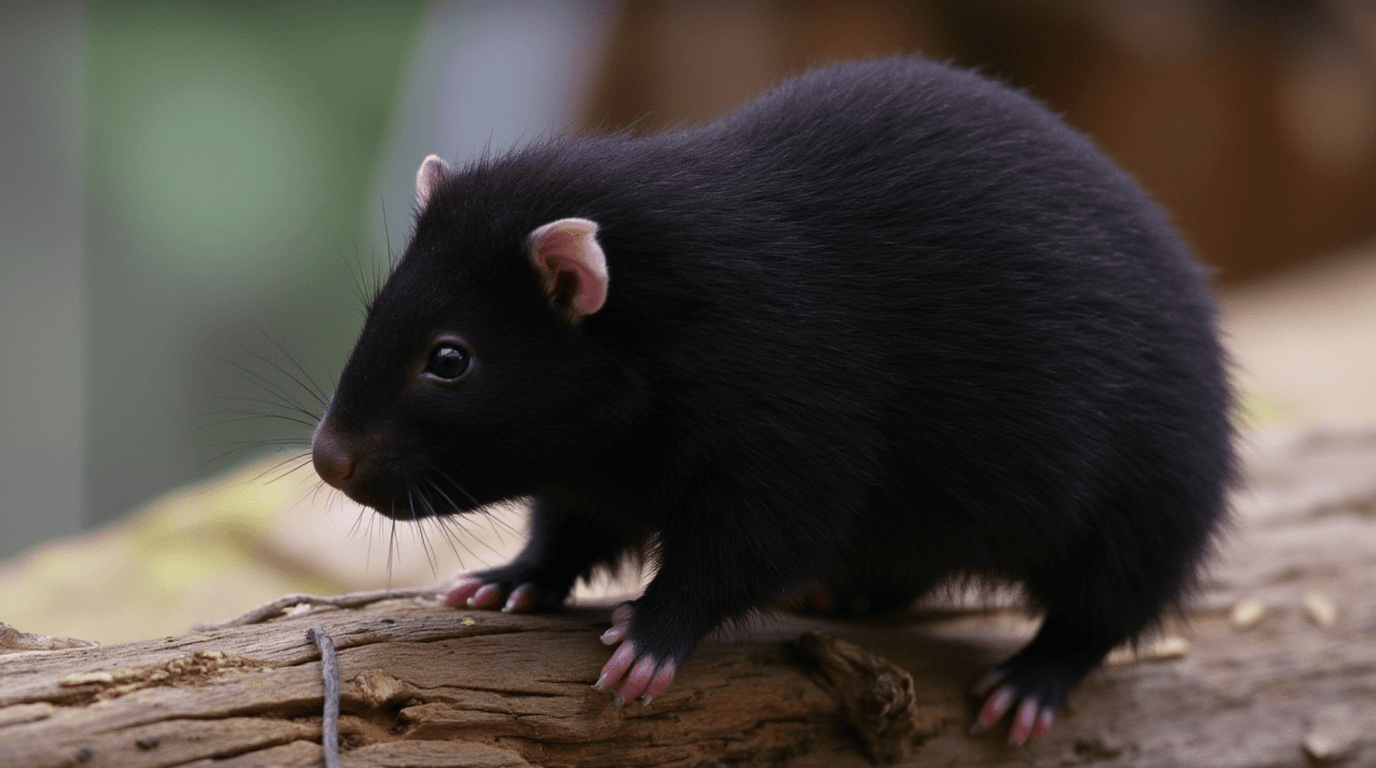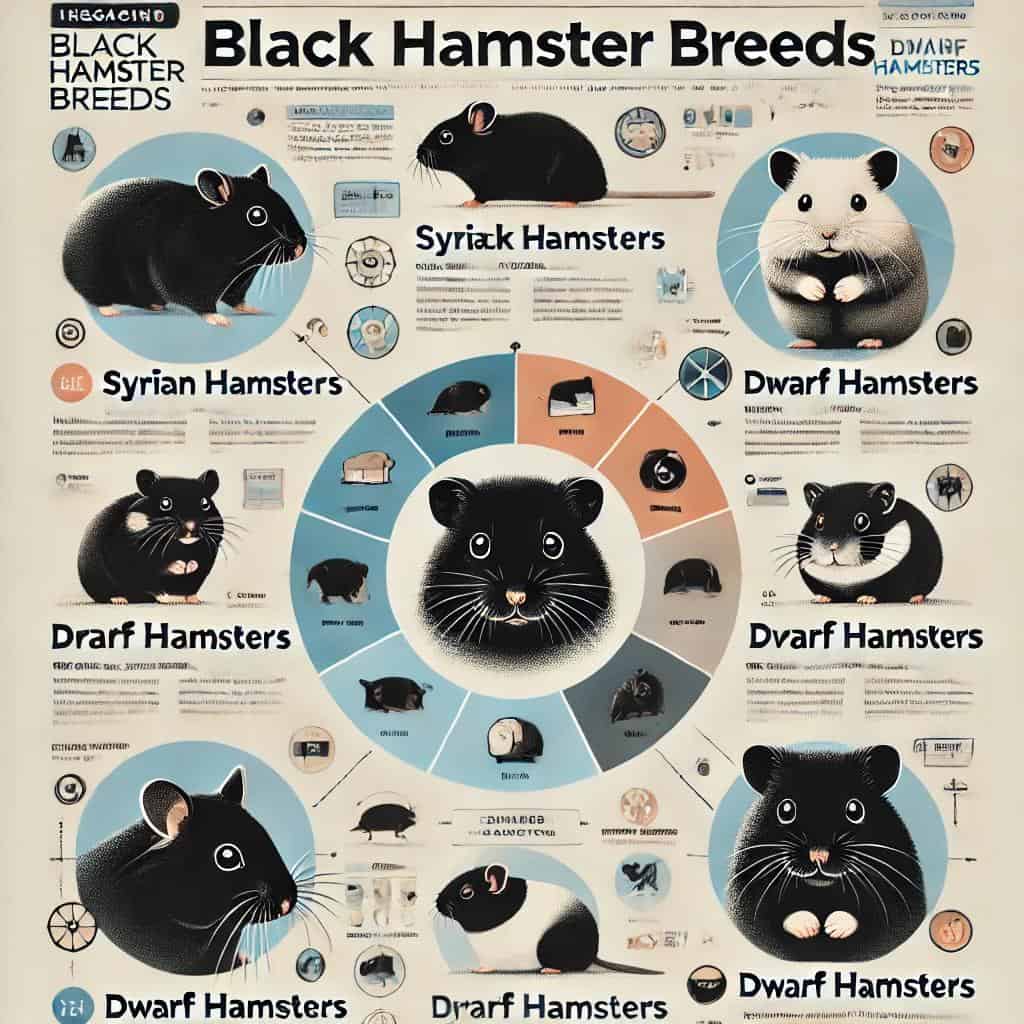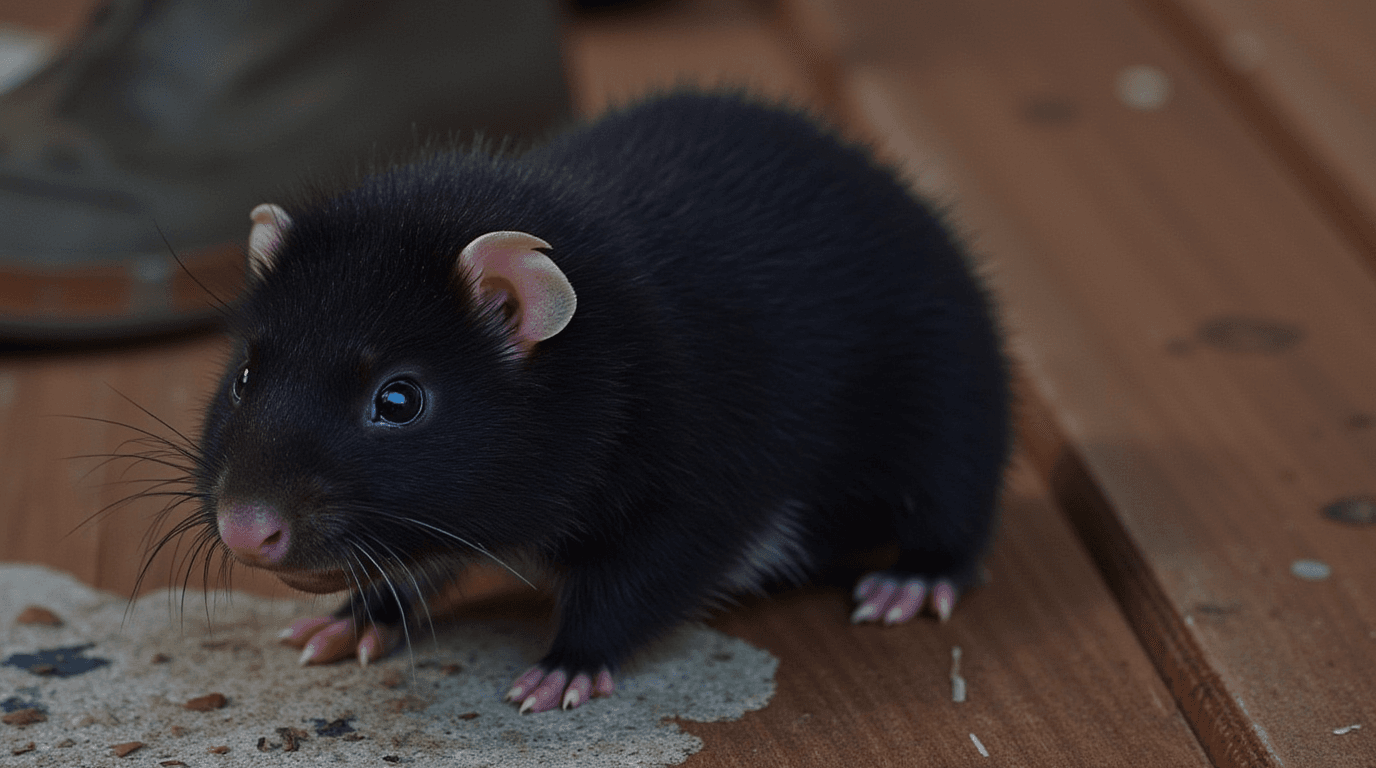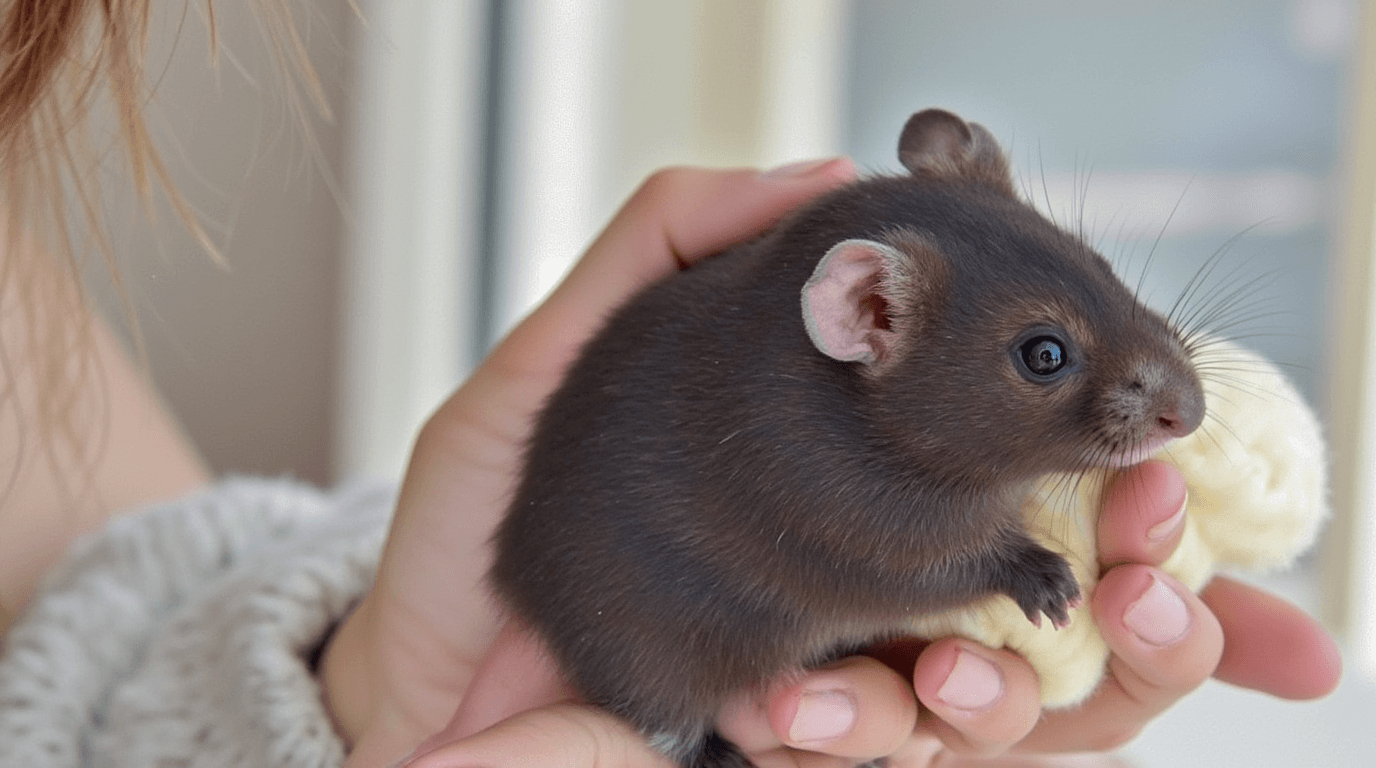Introduction:

Explore the world of black hamsters and see why they’re becoming more popular pets. This guide covers their unique traits, care needs, and more. It’s perfect for both new and experienced hamster owners.
Learn about the different black hamster breeds and what they need to be happy. Find out about their living spaces, behavior, and health. This article will help you make your black hamster’s life better.
- Unveiling the Allure of Black Hamsters
- Setting Up the Perfect Black Hamster Habitat
- Decoding Black Hamster Behavior and Personality Traits
- Nutritional Needs: A Well-Balanced Black Hamster Diet
- Grooming and Care Tips for Black Hamsters
- Black Hamster Health Considerations and Preventive Measures
- Conclusion
- FAQ:
Unveiling the Allure of Black Hamsters
In the world of exotic pets, black hamsters have won many hearts in the United States. They range from the sleek black bear hamster to the cute black teddy bear hamster. These hamsters stand out with their unique charm.

Black Hamster Breeds: Syrian and Dwarf Varieties
The black and white hamster is a real showstopper with its elegant bicolor coat. Syrian black hamsters are big and gentle, making great pets. On the other hand, the small dwarf black hamster is full of energy and curiosity.
The Mesmerizing Charm of Black Teddy Bear Hamsters
The black teddy bear hamster is a standout, with its soft coat and cute face. These hamsters are smart and beautiful, making them very popular. They are known for being among the smartest hamster breeds. Their cuddly nature and playful spirit make them a favorite, even if they are pricey.
“The black hamster is a true marvel, blending elegance and charisma in a captivating package.”
Setting Up the Perfect Black Hamster Habitat
Creating a cozy and fun home for your black hamster is key to their happiness. You need to pick the right cage size and add fun things to keep them entertained. Understanding their housing needs is the secret to a happy hamster.
Caging Requirements for Comfortable Living
When it comes to hamster housing, size is important. The nicest hamster needs a big, safe place to live. A cage that’s at least 24 inches by 12 inches is best. This lets them move around, burrow, and act naturally.
Choose a cage that’s strong and has good air flow. Make sure the bottom is solid to keep them safe from harm.
- Substrate: Give them soft, absorbent bedding like shredded paper or aspen shavings. This lets them burrow and nest comfortably.
- Nesting Material: Offer different nesting materials like hay, paper towels, and soft fabrics. This encourages them to burrow and nest naturally.
- Enrichment: Add lots of chew toys, tunnels, and hiding spots. This keeps their curiosity sharp and stops boredom.
A well-designed hamster housing environment is not just about comfort. It also supports their mental and emotional health. This leads to a happy and content pet.
Decoding Black Hamster Behavior and Personality Traits

Exploring the world of black hamsters reveals a rich tapestry of unique behaviors and charming traits. These small pets are more than cute; they have a deep character that makes them engaging and rewarding.
Black hamsters balance social and solitary traits. They may seem shy at first but are fiercely loyal to their owners. They are curious and love to explore, making them fun to watch.
Black hamsters vary in their activity levels. Some are day active, while others are night owls. But all are full of energy, leaving their owners amazed.
Their intelligence is a topic of debate. While not the smartest, they can solve problems and learn tricks. With patience and positive reinforcement, they can even learn simple tricks.
“Black hamsters are truly remarkable creatures, blending a curious nature, playful spirit, and an endearing charm that captivates all who encounter them.”
Understanding black hamsters’ unique traits helps owners bond with them. It creates a better environment for their pets. From their social nature to their intelligence, these pets offer endless joy and discovery.
Nutritional Needs: A Well-Balanced Black Hamster Diet
Keeping a black hamster healthy means giving them the right food. They need a mix of nutrients to stay well and happy. Knowing what they need helps pet owners give them the best life.
Hamster-Friendly Treats and Occasional Indulgences
While a balanced diet is key, treats can make mealtime fun. Hamster diet experts say to give them healthy snacks. These include fruits, veggies, nuts, and whole grain cereals.
These snacks meet their natural foraging needs and add vitamins and fiber. But, remember, treats should be given in small amounts. Too many can cause weight gain and health issues. So, it’s important to balance their diet carefully.
“The secret to a happy and healthy black hamster is a diet that nourishes both their body and their spirit.”
Grooming and Care Tips for Black Hamsters
Keeping your black hamster healthy is key. Proper grooming and care are essential. This guide will help you keep your furry friend happy and comfortable.
Nail Trimming and Coat Maintenance
Trimming your black hamster’s nails is vital for their foot health. Use small, sharp scissors for pet grooming. Be careful not to cut the quick (the blood vessel inside the nail).
Brushing their coat once a week with a soft-bristle brush is also important. It helps distribute natural oils and keeps their fur shiny.
Bathing and Cleaning
Bathing your black hamster should be rare. They are clean animals and groom themselves. If a bath is needed, use gentle, pet-safe shampoo and lukewarm water.
Be cautious not to put the water into their ears. Dry them thoroughly with a soft towel. Also, ensure that their environment is cleaned frequently to ensure it is healthy and free of odors.
Handling with Care
When handling your black hamster, be gentle. Utilize your hands to pick them up while supporting their entire body. Avoid grabbing them by the scruff or tail.
This prevents stress and injuries. Also, learn your hamster’s body language. Respect their need for personal space and quiet time.
By following these grooming and care tips, you’ll provide your black hamster with the best environment and attention. Keeping them healthy and happy is the heart of a rewarding hamster care experience.

Black Hamster Health Considerations and Preventive Measures
Keeping your black hamster healthy is very important. As pet owners, we must watch over our furry friends closely. This part talks about common health problems in black hamsters and how to keep them healthy.
Common Health Issues and Their Management
Black hamsters can get sick like any other small pet. It’s up to us to take care of them and prevent sickness. Here are some common health issues and how to handle them:
- Respiratory Infections: Black hamsters can get sick in their lungs or upper airways. Watch for sneezing, hard breathing, and runny noses. If you see these signs, take them to the vet right away.
- Dental Problems: Their teeth can grow too long or not line up right. This makes eating hard. Give them chew toys and check their teeth often to avoid problems.
- Skin Conditions: They might get skin problems, allergies, or mites. Look at their fur and skin often. If you see anything wrong, talk to a vet.
- Digestive Disorders: They can have stomach problems like diarrhea or constipation. Make sure they eat the right food to keep their stomach healthy.
By watching your black hamster closely, you can catch sickness early. This way, you can take care of them and keep them happy and healthy.
| Health Concern | Symptoms | Management Strategies |
|---|---|---|
| Respiratory Infections | Sneezing, labored breathing, nasal discharge | Consult a veterinarian, provide proper treatment and care |
| Dental Problems | Overgrown or misaligned teeth, difficulty eating | Provide chew toys, monitor dental health regularly |
| Skin Conditions | Skin irritations, allergies, parasitic infestations | Inspect coat and skin, seek veterinary guidance |
| Digestive Disorders | Diarrhea, constipation | Ensure a well-balanced, hamster-appropriate diet |
By taking care of these health issues and preventing them, you can keep your black hamster healthy. In this way, you will be able to take pleasure in their company for many years to come.
Conclusion
Black hamsters are a captivating and rewarding pet for hamster lovers. This guide has covered their allure, including the Syrian and Dwarf breeds. It also talked about the Black Teddy Bear Hamster’s charm.
It taught aspiring owners how to set up the perfect home for them. You learned about their unique behaviors and personalities. Plus, how to meet their nutritional needs with a balanced diet and treats.
If you’re looking for the best or nicest hamster, this guide has you covered. It gives you the knowledge to care for your black hamster. From grooming to health, it covers everything you need to know.
With this knowledge, you’re ready to start a rewarding journey with your black hamster. Whether you’re new to hamsters or have experience, this guide has the info you need. It helps you create a strong bond with these amazing creatures.
FAQ:
What is a black hamster called?
A black hamster is often referred to as a Black Syrian hamster or sometimes a Black Bear hamster due to its dark, glossy coat. This striking coloration is a result of specific genetic traits. Black hamsters are known for their unique appearance and share the same care requirements as other Syrian hamsters.
How rare is a black hamster?
A black hamster is considered relatively uncommon compared to other coat colors. This unique coloration is most often found in Syrian hamsters, resulting from specific genetic traits. While not exceedingly rare, a black hamster stands out for its striking, glossy coat, making it a sought-after choice among hamster enthusiasts.
What color hamster is rare?
Among hamsters, colors like albino and silver-grey are considered rare due to their specific genetic origins. A black hamster, while less common than standard golden or brown varieties, is also highly sought after. These unique coat colors add a touch of exclusivity, making them favorites among dedicated pet enthusiasts.
Do grey hamsters exist?
Yes, grey hamsters do exist and are found in various species, including Syrian and dwarf hamsters. Their soft grey fur often features subtle patterns or shades. While not as striking as a black hamster, grey hamsters are equally charming and showcase a unique, muted elegance that appeals to many pet lovers.
How long do black hamsters live?
A black hamster, like other Syrian hamsters, typically lives 2 to 3 years with proper care. Their lifespan depends on factors such as diet, environment, and overall health. Ensuring a balanced diet, a clean habitat, and regular interaction helps your black hamster thrive and enjoy a happy, fulfilling life.
Do white hamsters exist?
Yes, white hamsters do exist and are often referred to as albino or winter white hamsters. Their snowy coats and red or black eyes make them uniquely captivating. While not as bold as a black hamster, their pristine appearance and gentle nature make them a popular choice among pet enthusiasts.
What is the oldest hamster in history?
The oldest recorded hamster in history lived to be 4.5 years, significantly surpassing the average lifespan of 2-3 years. While this exceptional hamster was not a black hamster, it highlights the impact of optimal care and genetics. A balanced diet, clean habitat, and attentive care can help hamsters thrive longer.
Do hamsters hide illness?
Hamsters are adept at hiding illness, a survival instinct from their wild ancestors. Subtle signs, such as lethargy, changes in appetite, or unkempt fur, may indicate underlying health issues. Whether it’s a black hamster or any other color, regular observation and prompt veterinary care are crucial to maintaining their well-being.
Share your thoughts in the comments below! If you enjoyed this post, consider subscribing to our newsletter for more pet tips, stories and blogs!
